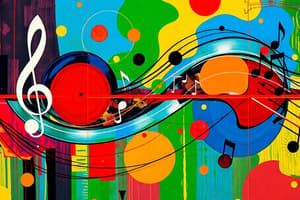Podcast
Questions and Answers
What does harmony in music refer to?
What does harmony in music refer to?
- The volume of sound produced
- A rapid succession of tones
- The rhythm of the music
- The combination of sounds that creates a pleasing effect (correct)
Dissonance results when the combination of sounds is in agreement.
Dissonance results when the combination of sounds is in agreement.
False (B)
What is the structure or framework of a musical composition called?
What is the structure or framework of a musical composition called?
Form
A __________ is a dramatic performance set to music, complete with actions and scenery.
A __________ is a dramatic performance set to music, complete with actions and scenery.
Match the following dynamics symbols with their meanings:
Match the following dynamics symbols with their meanings:
What is the primary role of a playwright?
What is the primary role of a playwright?
The setting of a story includes only the characters involved.
The setting of a story includes only the characters involved.
What term refers to the organization or patterns of movement in time and space in a performance?
What term refers to the organization or patterns of movement in time and space in a performance?
The __________ are the persons involved in the story.
The __________ are the persons involved in the story.
Match the following elements of theater with their descriptions:
Match the following elements of theater with their descriptions:
Flashcards are hidden until you start studying
Study Notes
Elements of Music
- Rhythm: Consists of movements or patterns featuring alternating accented and unaccented beats.
- Melody: A series of tones arranged musically which rise and fall over time, creating a cohesive tune.
- Harmony: The simultaneous sounding of tones, producing concordance (pleasing combinations) or dissonance (unpleasant sounds).
- Timbre: The quality or character of sound produced by instruments or voices, distinguishing different sources of sound.
- Form: The structural framework of a musical composition.
- Vocal Forms:
- Opera: A musical drama with actions, costumes, and scenery.
- Cantata: A narrative delivered in music, focused on religious themes without actions.
- Moro-Moro: A Philippine musical drama depicting the conflict between Christians and Muslims.
- Instrumental Forms:
- Sonata: An extended piece for solo instruments.
- Symphony: A sonata composed for orchestral performance.
- Vocal Forms:
- Dynamics: Regulates sound's volume through symbols indicating loudness and softness.
- pp: Very soft (pianissimo)
- p: Soft (piano)
- mp: Half soft (mezzo piano)
- f: Loud (forte)
- ff: Very loud (fortissimo)
- Crescendo: Gradually increasing volume.
- Decrescendo: Gradually decreasing volume.
Elements of Dance
- Music: Integral to dance, providing melody and harmony to align with movements.
- Movement: The physical expression of dancers creating organized patterns.
- Choreography: Arrangement and connection of dance steps for seamless performance.
- Technique: The dancer's skill in executing movements proficiently.
- Theme: The central idea or message conveyed through the dance.
- Design: Organized patterns of movement concerning timing and spatial arrangement.
- Costume: Reflects the cultural customs and environment relevant to the dance performance.
Elements of Drama
- Genre: Drama is a performance-based genre of literature intended for live audiences.
- Plot: The overarching structure of the play, including a beginning, middle, and ending phases:
- Exposition: Introduction of characters and setting.
- Complication: The development of conflict.
- Resolution: Conclusion and resolution of the conflict.
- Setting: The time and place where the story unfolds, including scenery and props.
- Characters: Individuals in the narrative brought to life through well-structured dialogue.
- Dialogue: The spoken words exchanged among characters.
- Theme: The deeper meaning and significance of the story derived from the integration of elements.
Elements of Theater
- Playwright: Responsible for crafting the plot and dialogue for performance.
- Performers: Actors who portray the characters within the play.
- Director: Collaborates with the playwright to interpret the work and guide its execution.
- Production Design: Encompasses all visual and physical elements, including scenery, props, costumes, and makeup.
Elements of Cinema
- Acting: The craft of embodying characters and storytelling through performance.
- Set and Art Directors: Create artificial environments that reflect the film's setting.
- Music and Musical Director: Essential for enhancing the emotional depth of films.
- Color: A significant advancement in cinematography that adds visual richness.
- Make-up, Hair, and Costume Design: Crucial for character portrayal and visual storytelling.
- Sound, Camera, and Special Effects Technicians: Ensure quality production through technical expertise in sound capture, camera work, and special effects.
Studying That Suits You
Use AI to generate personalized quizzes and flashcards to suit your learning preferences.




